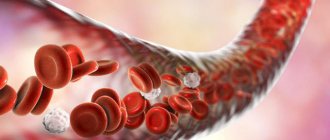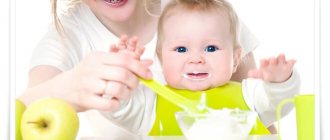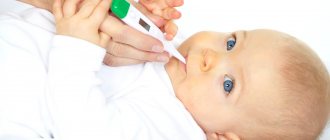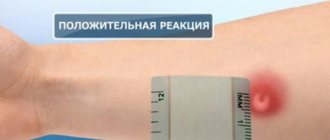Bilirubin in newborns: norm, deviations, treatment of jaundice
One of the important indicators of a child’s health immediately after birth is the level of bilirubin in the blood, which is not stable in the first days of life and causes anxiety in young mothers, turning the baby’s body a jaundiced color. What should be the level of bilirubin in newborns, how to distinguish normal from pathology, and also choose the right treatment tactics? Only a pediatrician can answer these questions in detail after closely monitoring the baby’s condition, but in our article you will read basic information on this topic.
Normal bilirubin content in a newborn
It should be noted that in the results of a blood test for bilirubin in a newborn, its indicators are the same as in an adult. They are measured in micromoles per liter. So, a general indicator of 3.4-20.5 µmol/l is considered normal for a baby; direct indicator 0.7-5.1 µmol/l; indirect indicator 1.7-15.4 µmol/l.
If we talk about percentages, then in general the percentage of direct bilirubin should be 25%, indirect - 75%. And the yellowness of the baby’s skin is an increase in the total bilirubin level above 27-34 µmol/l. With this indicator, yellowness of the conjunctiva of the child’s eyes is also possible.
What happens in the baby's body
The fact that a few days after being outside the womb, bilirubin in newborns begins to increase is explained by the physiological peculiarity of the restructuring of the body. This period is characterized by the following processes:
- as there is no need for a large amount of hemoglobin, it begins the process of decay;
- when deformed, red cells release bilirubin - a special pigment that participated in the formation of iron-containing protein - hemoglobin and is released into the blood in an abnormally large volume;
- the accumulation of bile pigment in the bloodstream increases;
- the dermis and sclera are painted in the tone of the pigment - yellow-mustard.
At the beginning of life outside the womb, the baby’s liver is simply not able to cope with high bilirubin levels, since its functionality is not yet fully developed. This condition is considered transient (transitional, temporary), and corresponds to the norms of physiological development of the child. This type of jaundice is called physiological and does not require special treatment.
So does breastfeeding jaundice. After childbirth, the concentration in milk of hormones that reduce the activity of liver enzymes is high, and during natural feeding they penetrate into the baby’s body, causing jaundice. With an increase in the amount of milk in the breast, everything returns to normal and the baby recovers.
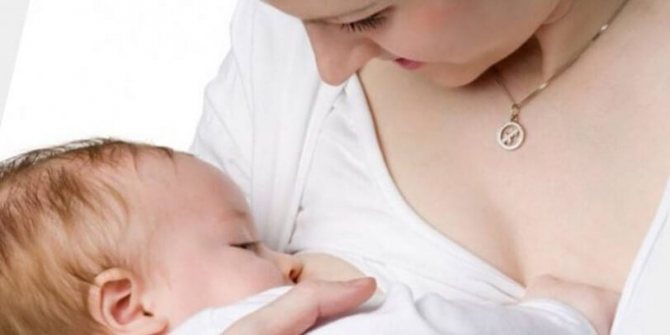
Important! There is no need to rush to interrupt breastfeeding, which can later become a panacea for the child. However, in order to dispel doubts and make sure that the cause of yellowing of the skin is not liver pathology, you can transfer the baby to artificial feeding for several days. If during this time the color of the skin returns to normal, it is recommended to resume breastfeeding without delay.
What is the normal level of bilirubin in a newborn?
Bilirubin in the blood is presented in two fractions:
- Indirect (free), which is formed as a result of the fact that the rate of breakdown of red blood cells is higher than the ability of the liver to bind bilirubin. Free bilirubin is a substance that tends to dissolve only in lipids (fats). Due to its inability to dissolve in water, the pigment is very toxic, accumulates in the bloodstream, causing characteristic staining, and can disrupt the normal functioning of cells, easily penetrating into them.
- Direct (bound) bilirubin is formed directly in the liver. After biochemical interaction with the organic acid of the uronic acid group and liver enzymes, which reduce the toxicity of the pigment, it becomes soluble in water and is easily excreted from the body along with bile and urine.
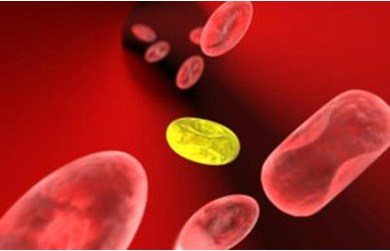
The indicators of the two fractions add up to the total concentration of bilirubin in the blood, with direct bilirubin accounting for no more than 25% of the total volume.
In order for free bilirubin to become bound and soluble, it must be transported to the liver by certain proteins that newborns lack. As a result, the level of bilirubin in the blood increases, and physiological jaundice occurs.
The table shows the norms of bilirubin levels in infants (table of bilirubin in newborns by day)
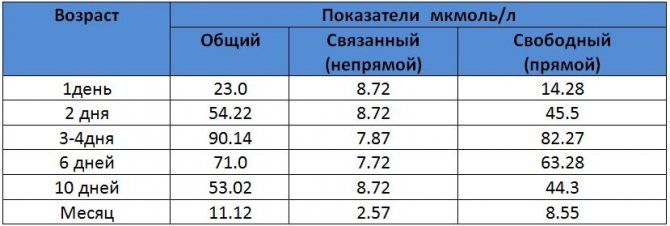
Jaundice develops in newborns if bilirubin levels are above 50 µmol/l and is expressed, in addition to the concentration of pigment in the blood, by changes in the condition of the infant’s skin: initial color, capillary tone, the extent of the pigment distribution area.
To assess the intensity of changes in indicators, the Cramer scale is used, which can be used to assess the severity of the child’s condition:
- The head area turns yellow (eye sclera, face, palate, tongue below) - 100 µmol/l.
- Yellowness descends to the upper area of the body above the navel - 150 µmol/l.
- The area below the navel is added, including the buttocks and thighs - 200 µmol/l.
- The upper and lower extremities are painted with pigment - 250 µmol/l.
- Skin changes color throughout the body, including fingers, toes, palms and feet - over 250 µmol/l.
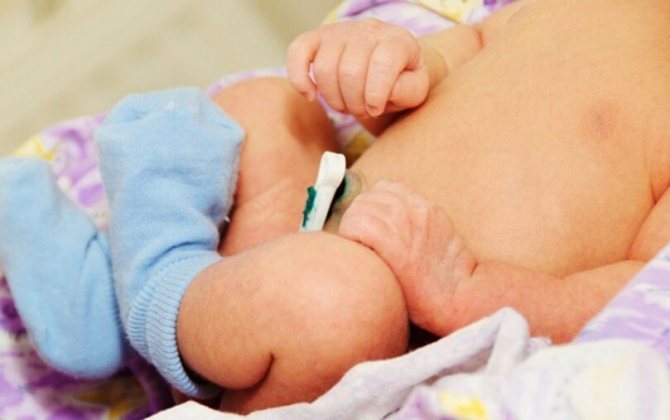
The higher the indicator, the more serious the reason to assume that the child has jaundice of various types and degrees of severity and such complications as gallbladder dyskinesia.
For full-term infants, the critical indicator will be the concentration of bilirubin in the bloodstream above normal and up to a limit of 250 µmol/l, for those born prematurely - 200. Infants born prematurely have a greater risk of being in the group diagnosed with “jaundice” due to underdevelopment of body systems and increased sensitivity to adverse conditions.
Indirect bilirubin toxins can cause damage to the deep structures of the anterior part of the brain, which are responsible for motor activity and coordination, and cause bilirubin encephalopathy (kernicterus). This condition provokes:
- increased drowsiness or extreme agitation;
- decreased sucking reflex;
- increased muscle tone in the back of the head.
Important! Parents should know that excessive readings negatively affect the functioning of the brain and biliary organs. If the skin of a newborn suddenly turns yellow-brown, you should seek medical help without delay. Only a decrease in bilirubin levels will help avoid toxic poisoning with bile pigment.
In the absence of pathology, within 2-3 weeks from the moment of birth, the level of direct bilirubin gradually decreases and returns to normal; it is during this period that the physiological jaundice of the baby disappears completely and does not return.
Bilirubin in newborns
Bilirubin is a yellow-red pigment that is formed during the breakdown of hemoglobin and is part of bile. In medicine, it is usually divided into two types:
- indirect, insoluble in water;
- direct, which is highly soluble in water and is formed during the processing of indirect bilirubin in the liver.
If a child's jaundiced skin is not accompanied by other alarming symptoms, the doctor, as a rule, does not intervene. Otherwise, he prescribes a complete blood test for bilirubin to determine its level in the blood.
Measure your bilirubin level at home!
Call us today and we will bring the Bilitest device for you. The cost of the service is from 300 rubles.
More details
Causes and consequences of high bilirubin in newborns
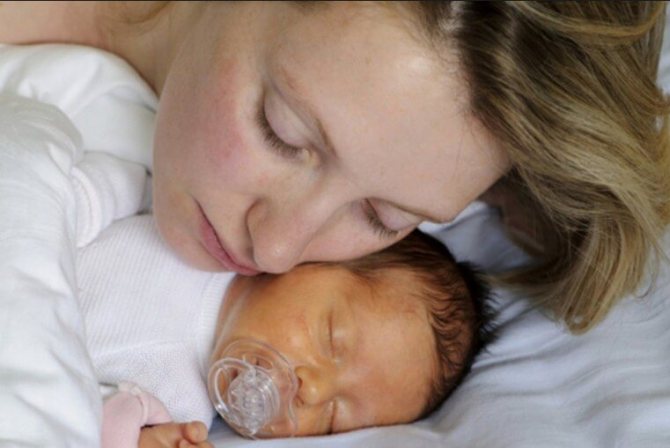
More than half of full-term babies and ¾ of premature babies suffer from jaundice in the first days. The risk group also includes:
- twins;
- children whose mothers have diabetes.
In order to recognize the pathology in a timely manner, blood from the umbilical cord is immediately taken from the newborn for analysis at the time of birth and again on the third day of life. This allows doctors to keep the situation under control and, if necessary, take emergency measures to preserve the health and life of the baby.
If after 2-3 weeks signs of jaundice continue to actively appear, doctors may suspect pathological jaundice, as a result of an increased concentration of bilirubin in the blood. The reasons for this condition may be:
- Hemolytic disease of newborns. This serious disease occurs against the background of rhesus - conflict between mother and child. It manifests itself as congenital internal edema of the subcutaneous tissue, an enlarged spleen and liver, and damage to the central nervous system.
- Genetic failure. In this case, the newborn may experience one of the following conditions: a defect in the formation of liver enzymes (Gilbert syndrome), decreased enzyme activity (Crigler-Najjar syndrome) and a deficiency of essential enzymes (Lucey-Driscol syndrome). With timely treatment, full compensation is possible, provided there is no severe damage to the brain nuclei.
- Damage to the liver by dangerous infections while the child is in the womb. Toxic agents and viruses reduce the ability to bind bilirubin and provoke parenchymal jaundice. This condition is characterized by prolonged jaundice, enlarged lymph nodes, darkening of urine and lightening of stool, and changes in biochemical blood tests.
- Blockage (obstruction) of the bile ducts, which occurs due to intrauterine cholelithiasis, the presence of a tumor in the body that compresses the bile ducts, bile thickening syndrome. This type of jaundice is called obstructive. The problem is solved by surgical intervention.
Normal value of total bilirubin in a one-month-old baby
The total bilirubin indicator in each laboratory has its own units of measurement. The most common unit is micromoles per liter (µmol/L). In a newborn baby, in the first days of life, bilirubin levels are elevated:
- in babies born at term, bilirubin is up to 256 µmol/l;
- in premature babies – up to 170 µmol/l;
- The norm of bilirubin in a one-month-old baby, as in an adult, ranges from 8.5-20.5 µmol/l.
Table:
| Age | Norm of bilirubin, µmol/l |
| 1 day from birth | 60 |
| 3rd day from birth | 256 |
| 1 month from birth and older | 8,5-20,5 |
| Premature baby | up to 170 |
A video will help you better understand what bilirubin is and why you need to find out its indicators.
Treatment of elevated bilirubin in the maternity hospital and with home remedies
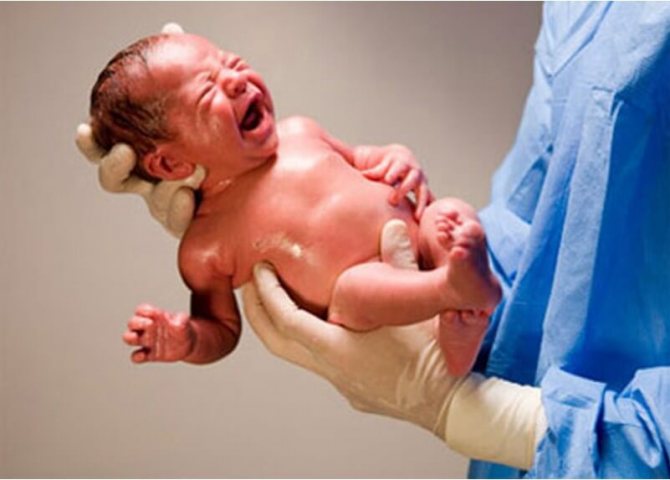
Doctors in the maternity hospital are required to monitor bilirubin levels in the blood of newborns. To get a complete systemic picture of pigment concentration, they prescribe biochemical blood tests throughout the baby’s stay in the hospital (2-3 times) and monitor the tendency for bilirubin levels to increase or decrease.
Mothers can keep this topic under control and ask the doctor whether such a test was taken from the child and what the results of the laboratory test are.
It is this approach that makes it possible to timely identify jaundice and prescribe measures appropriate to the child’s condition to treat this disease.
Important! If the baby has mild symptoms of jaundice, is active and breastfeeds well, no treatment is required! With continued breastfeeding, after a week the skin, mucous membranes and sclera are completely normalized.
Experienced specialists, as a rule, accurately determine the severity of the disease and all kinds of risks, in contrast to the advice of friends and general information on the Internet
In this case, young mothers should be patient, and if the child needs to remain under the supervision of a doctor for some more time, do not refuse this, do not take responsibility, and do not put the life and health of your child at risk.
After all the necessary studies - visual and laboratory - the specialist makes an appointment and gives recommendations.
Treatment with a photo lamp
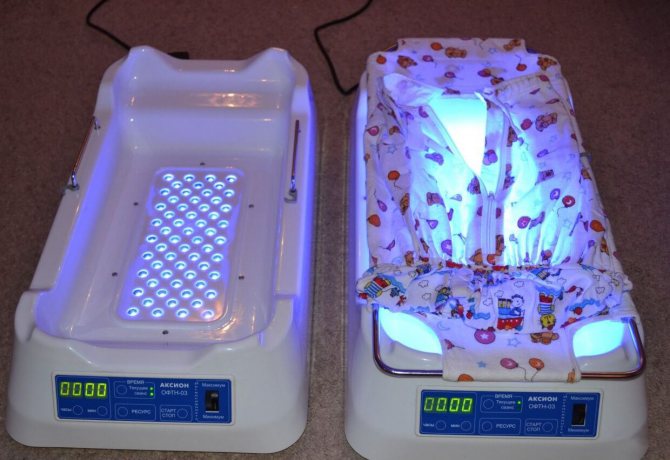
Phototherapy is considered the main and effective treatment for jaundice in newborns. The therapeutic result is given by the peculiarity of light waves of a certain length to affect bilirubin. The child is freed from clothes and a special lamp is pointed at his body. During the absorption of light radiation, bilirubin molecules are converted into a soluble substance - lumirubin, which is harmless to the child’s body, since it is absolutely non-toxic and is easily excreted from the body with urine and bile.
For this procedure, in addition to a lamp, special glasses, a blindfold, mattresses and blankets are provided. The manipulation is completely painless and comfortable, does not require emotional stress - the baby does not have to separate from his mother to carry it out. In addition, maternity hospitals practice the use of special lamps in shared wards, where the mother can independently monitor the child’s condition.

Long-term herbal therapy brings good results, and the baby can be exposed to light radiation from several hours to several days during one session. In between procedures, it is necessary to devote time to feeding the child, caring for him and resting.
Important! The more milk a mother has, the lower the concentration of enzymes that prevent the liver from coping with high levels of bilirubin.
If the number of procedures during a stay in the maternity hospital is not enough and the level of a dangerous pigment in the blood increases, the baby is separated from the mother and proceeds to more intensive treatment.
Drug therapy
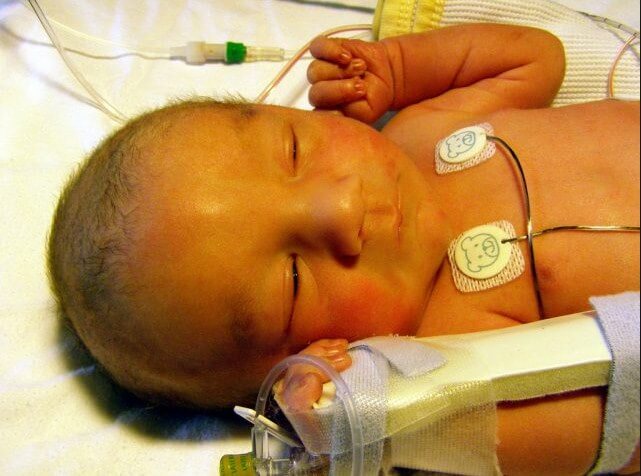
For complete and comprehensive treatment, doctors prescribe medications that help infants overcome the complications of jaundice:
- Elkar. The active substance of the drug is a special amino acid L-carnitine, which is responsible for normalizing energy metabolic processes. By stimulating the activity of lipid metabolism, the content of bilirubin in tissues, bloodstream and organs can be minimized. This increases the functional ability of the liver - it neutralizes bilirubin, reduces its toxic effect, which gives hope for a favorable prognosis.
For infants, this medication is available in drops and injection solution with 20% content of the main substance. If intravenous and intramuscular injections are recommended to be carried out in a hospital setting in order to make it easier to monitor the baby’s reaction to the drug, then after discharge at home the child can be given drops on their own. The main thing is to follow the doctor’s recommendations and act strictly according to the instructions.
- Ursofalk. A new generation drug, which is designed to eliminate the symptoms and signs of a diseased liver, has a wide spectrum of action, helping the liver to activate its functionality. As a result of this stimulation, the organ more actively begins to bind bilirubin, neutralize it and remove it from the body. Doctors greatly appreciate the ability of this medicine to remove the toxic load, reduce the likelihood of brain damage and prevent such a complication of the disease as kernicterus.
The drug for newborns is available in the form of a suspension - a medicinal suspension, which is pleasant to the taste and easy to dose. The single dosage and course of treatment is calculated by the pediatrician after analyzing the child’s condition and comparing the risks of possible complications of jaundice and adverse reactions of a fragile body to a strong medication. In this regard, parents need to know that there are restrictions on taking the drug for those children who have serious pathologies of the biliary tract and kidneys.
- Hofitol. Homeopathic remedy of plant origin with a pronounced choleretic effect. This drug protects and supports the liver, restores its cells, helps hemoglobin acquire a soluble form, improves metabolism, and treats gallbladder diseases.
What is bilirubin?
Bile pigment is formed from the breakdown products of red blood cells, participates in metabolism and is closely related to the functioning of internal organs. In the fetus's body there is another, fetal red blood pigment. When the baby takes his first breath, hemoglobin breaks down and forms bilirubin, so in all newborns this coefficient is increased, which is considered normal.
Sometimes the newborn’s organs are not able to cope with a large amount of bilirubin, in which case they speak of pathological jaundice. The baby's face, neck, and then the rest of the body are painted yellow first. This condition does not bother the baby; only a very high bilirubin content threatens severe brain intoxication.
Direct, indirect and total bilirubin
In the study of bilirubin, three indicators should be noted: total, direct and indirect, the relationship between them is indicated. In the body, there are actually direct and indirect bilirubin, and the total indicator sums up the first two. Direct bilirubin is non-toxic, soluble and is easily excreted from the body naturally.
Indirect bilirubin combines with fats, it is toxic and accumulates in tissues. To remove it, you need to convert the substance using gastric enzymes into direct bilirubin. This approach is necessary when the liver’s function in processing indirect bilirubin is impaired.
Usually the majority is indirect bilirubin. Normally, its indicator is 75% of the total. For a newly born child, this ratio is different. In the first few days of life, bilirubin is always indirect. It is present in the child’s blood and does not come out on its own; special enzymes are needed to remove it, the activity of which is still low in the baby. When they appear, the enzymatic system will become more mature, and all the “bad” pigment will be removed.
Normally, after 2-4 weeks, physiological jaundice should go away; if this does not happen, they speak of pathological jaundice. The child is hospitalized in the neonatal pathology department. In mild cases, the baby is left for home treatment using a phototherapy device.
Table of normal indicators in newborns
Bilirubin levels for full-term and premature babies differ. To understand what is normal for a particular age, let’s look at the table. Values are given in µmol/l.
| Age | Norm of bilirubin for full-term babies | Norm of bilirubin for premature babies |
| 24 hours | up to 85 | up to 97 |
| 36 hours | up to 150 | Up to 120 |
| 48 hours | up to 180 | up to 150 |
| 3-5 days | up to 256 | up to 171 |
| 6–7 days | up to 145 | up to 145 |
| 8–9 days | up to 110 | up to 97 |
| 10–11 days | up to 80 | up to 50 |
| 12–13 days | up to 45 | up to 35 |
| More than 14 days | up to 20.5 | before 18 |
If there is no reduction to the normal level or the amount of the substance is significantly increased, then this indicates prolonged jaundice. For example, if the reading is 300 µmol/l, you need to consult a doctor.
The second table shows the norms of bilirubin content by fraction:
| Child's age | General | Connected | Free |
| Newborns | 23,09 | 8,72 | 14,37 |
| 2 days | 54,22 | 8,72 | 45,50 |
| 4 days | 90,14 | 7,87 | 82,27 |
| 6 days | 69,10 | 7,72 | 63,28 |
| 9 days | 53,02 | 8,72 | 44,30 |
| 30 days | 11,12 | 2,57 | 8,55 |
Norm of total bilirubin
The amount of bilirubin in the blood is measured in µmol/l. To determine deviations, doctors determined the limits of normal values for this enzyme. Indicators vary for each type of pigment (indirect, direct, general), age and gender of the person. Women have slightly lower levels compared to men due to fewer red blood cells in the blood. General indicators of normal bilirubin are reflected in the table:
| Patient category | Total bilirubin in blood serum, µmol/l |
| Women | 5,1-17,3 |
| Men | 5,5-20,5 |
| Children over 1 month | 8-20,5 |
| Children up to 2 weeks of life | 28-210 |
| Newborns | 24-190 |
Find out how to become a nutritionist in 30 days and earn an additional 50,000 rubles. per month!
How is a bilirubin test done in infants?
Bilirubin is measured by taking blood from the umbilical cord, then a blood test is taken 2 days later. For premature babies, this procedure is repeated every day for a week. In children without pronounced signs of jaundice, the level of bilirubin is determined by a special device - a digital bilirubinometer. The procedure is painless, measurements are taken in the area of the forehead, chest and bridge of the nose.
The second way to determine how much bilirubin a baby has is a blood test. It is taken from the heel of a newborn with a special needle and should be taken on an empty stomach. A month later, the study is done again, blood is taken from a vein - this is a common practice for newborn children.
If the indicators are consistently elevated, the baby will be left for treatment in a hospital, because he requires observation and therapy until complete recovery, that is, the pigment content in the blood decreases to a normal level. The doctor at the hospital will order additional tests:
- general blood analysis;
- analysis for total, direct and indirect bilirubin;
- Coombs test (for hemolysis);
- a comprehensive blood test for liver and biliary tract diseases;
- Ultrasound of the abdominal organs;
- consultations with other specialists.
If, while already at home, parents discover disturbing symptoms, they should contact their pediatrician and get tested again. This is necessary when detecting:
- drowsiness;
- severe anxiety;
- tachycardia;
- enlarged liver and spleen (we recommend reading: what does an enlarged liver mean in a child according to ultrasound?);
- the appearance of seizures;
- maintaining jaundice.
If, upon discharge from the maternity hospital, the yellowness of the baby does not go away and other symptoms of increased bilirubin are added, you should definitely contact your pediatrician
Bilirubin in newborns: norm, table, stages
Every young mother is concerned about anything that could harm the baby. And when, after the long-awaited 40 weeks of waiting, her newborn baby is born, and the doctor says that her child has jaundice, the mother is worried. And all this is quite understandable. Therefore, let's take a closer look at what jaundice is in newborns, when it is dangerous and when it is not.
What causes the skin to turn yellow?
The appearance of a jaundiced tint occurs due to an increase in the level of bilirubin pigment in the baby’s blood. Its level rises on the second (third) day of the baby’s life, and returns to normal by the month.
In healthy newborn babies, normal physiological jaundice occurs due to the breakdown of the indirect hemoglobin protein with the subsequent formation of the bilirubin pigment, an increase in the level of which gives the skin a jaundiced tint. And since the baby’s liver cannot yet neutralize it in a timely manner and remove it along with bile, the baby’s skin turns yellow. The increase in bilirubin is normally temporary; over time, the metabolism in the baby’s body normalizes and the jaundice goes away.
Why does bilirubin go off scale?
An increase in bilirubin in newly born babies occurs because in the first day of a person’s life, fetal hemoglobin is intensively replaced by normal hemoglobin. It breaks down and changes to form the pigment bilirubin.
The process of increasing bilirubin is also facilitated by an insufficient amount of albumin, which is responsible for the absorption of indirect bilirubin by the liver. And the liver itself, as well as metabolic processes, are still immature. By the first month of life, all these processes are normalized and the baby’s bilirubin level is brought to the adult norm.
Bilirubin indicators
The normal level of bilirubin in a newborn baby always exceeds that of a month-old baby and adult.
In a full-term baby, a reading of 35-50 µmol/l is considered normal, but the level of pigmentation can increase to 256 µmol/l. In babies born prematurely, this figure reaches 171 µmol/l. Even though the baby’s skin turns yellow, these indicators are considered acceptable.
The critical level of pigmentation in the blood of newborns born at term is considered to be 324 µmol/l. The critical level of bilirubin in babies born prematurely is 150-250 µmol/l. With such indicators, doctors usually sound the alarm. And their fears are completely justified.
What can jaundice lead to?
The threat to a baby with increased bilirubin is due to the fact that this pigment does not dissolve in water. This means that it is impossible to remove it from the child’s body naturally. But it is fat soluble, and is quite capable of settling in the subcortex of the brain. Deposition in the zone of the subcortical nuclei can lead to bilirubin encephalopathy, in other words, kernicterus. This happens due to intoxication of the subcortex of the brain. And it is extremely dangerous, as it can lead to disability of the baby, and sometimes ends in death.
Symptoms of kernicterus are:
- drowsiness, lethargy of the baby;
- the baby does not suck well at his mother’s breast;
- convulsions;
- loud, incessant crying;
- neck muscle tension.
It is precisely because of the danger of kernicterus that the level of bilirubin in the baby’s blood is thoroughly checked by doctors while he is in the maternity hospital. If the level is elevated, even slightly, bilirubin levels are tested three times a day.
How to independently recognize harmless jaundice:
- the skin becomes colored on the 2-3rd day, but never before the first day of life;
- the level of pigmentation increases gradually in the first 3-4 days of life;
- jaundice begins to disappear from the first week to the 10th day of life, and completely disappears by the second or third week;
- the baby feels well;
- the liver and spleen are not enlarged;
- stool and urine are of normal color.
Clinical signs of physiological jaundice in newborns (recognized by doctors). At birth, bilirubin taken from the umbilical cord is less than 51 µmol/l; the level of hemoglobin, red blood cell count and hematocrit corresponds to the norm; Bilirubin in the first day increases by 5.1 µmol/l per hour; The maximum permissible total bilirubin, estimated on days 3-4 of life, is not reaches a value of 256 µmol/l in children born during; and the indicator is 171 µmol/l in children born earlier than expected. The average bilirubin analysis is 103 - 137 µmol/l;
The indicator of skin colorability is usually assessed using the Cramer system:
StageDescription
| I Art. | Only the face and neck are painted |
| II Art. | The skin is yellow up to the umbilical area |
| III Art. | The upper limbs turn yellow |
| IV Art. | All skin turns yellow |
Treatment of jaundice
If the level of pigmentation does not exceed the above indicators, then it is not reduced, since by 3-4 weeks of the baby’s life it will stabilize on its own. But if the level is elevated, then it is brought back to normal by phototherapy or donor blood transfusion. Phototherapy is indicated for readings of no more than 285 µmol/L for a full-term baby, and for a baby weighing less than 2 kg - 240 µmol/L. For more severe cases, doctors use blood transfusions.
Video - Dr. Komarovsky will talk about the different types of jaundice and methods for their differentiation
moy-kroha.info
Increased pigment levels
The most common reason for high bilirubin levels is that the young child's liver is not doing its job. This occurs due to decreased levels of enzyme activity.
The cause of late jaundice is breast milk. This happens when it contains a lot of estrogens, which prevent the baby from removing bilirubin from the body.
Reasons for the increase
It is difficult to determine why bilirubin levels increase. There are suspected causes of physiological jaundice:
- prematurity (although some babies born prematurely have even lower pigment levels);
- infectious diseases of the mother during pregnancy;
- maternal diabetes;
- oxygen starvation of the baby during childbirth;
- taking certain medications by a woman while carrying a baby.
All causes of increased bilirubin are indirect - for example, the bile pigment of a newborn can be influenced by the state of health of the mother during pregnancy.
What causes the pathological form? There are different sources:
- incompatibility of the blood type of mother and child;
- Rhesus conflict;
- hepatitis of the newborn;
- disorders of the gastrointestinal tract;
- premature birth.
If the indicators are too high, nothing bothers the baby, he eats well, actively grows and develops. In this case, you can stop breastfeeding for 2-3 days, the jaundice will go away on its own. As a rule, no treatment is required, everything returns to normal by the 3rd month of life.
Consequences of high bilirubin
A significant and prolonged increase in the concentration of this pigment causes serious damage to health, especially the brain and nervous system. As a result, deviations in the general development of the child, mental disorders occur, and in extreme cases, hearing and vision are lost.
There should absolutely be no self-medication; pathological jaundice in newborns should be treated only under medical supervision. All babies who have been exposed to high levels of bilirubin are registered with a pediatric neurologist for at least 1 year.
Low bile pigment levels
Reasons for the decline
Low bilirubin is much less common than high bilirubin. For diagnosing the disease, cases when the coefficient is significantly reduced are important. To date, scientists have not fully studied the mechanisms that lead to a decrease in its concentration. However, the reasons for such indicators of the substance in the blood may be:
- chronic malnutrition;
- low hemoglobin level and low concentration of red blood cells (erythrocytes);
- iron deficiency.
Often, low direct or indirect bilirubin is a violation of the blood test method. The results of the study may be affected by taking certain medications, including antibiotics and ascorbic acid.
Reduced bilirubin levels are diagnosed much less frequently than elevated ones
What does a low concentration in the blood indicate?
If a reduced concentration of pigment is found in the lymph, this means that very little of it is formed during the breakdown of hemoglobin. The condition of the body indicates that the patient has a decreased amount of hemoglobin, and the tissues do not receive enough oxygen. Sometimes the parameter speaks about diseases:
- chronic renal or liver failure;
- aplastic anemia;
- acute leukemia;
- tuberculosis;
- various infectious diseases.
In adults, a reduced amount of the enzyme may be due to stagnation of bile, so its content can be increased with proper nutrition and physical activity. In children, therapy consists of identifying the causes and treating the disease that caused the decrease in the indicator. Folk remedies are used only as auxiliaries, in parallel with the use of medications.
What does low bilirubin mean?
The levels of bilirubin in the blood of newborns are always higher than in adults, and situations in which low levels of this pigment are diagnosed are very rare. Low bilirubin may result from:
- taking certain medications - barbiturates, hormones, antibiotics;
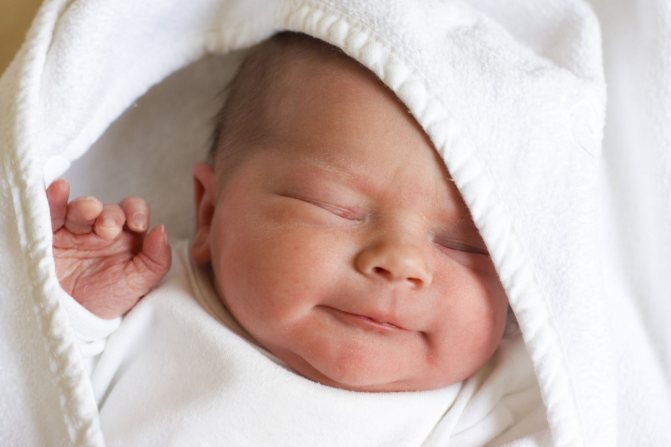
- drinking alcoholic beverages and strong coffee;
- unreliable analysis results.
The first two points concern the mother of the baby, so it is very important to listen sensitively to yourself and your health throughout the 9 months of pregnancy, give up bad habits, and use medications only with the permission of a doctor.
Therapy methods to reduce bilirubin levels
Physiological jaundice does not require special treatment - if the coefficient has increased, doctors recommend feeding the baby with breast milk, so he will quickly cope with excess bilirubin in the body. Formula-fed babies need to drink plenty of fluids. For pathological jaundice, a number of procedures are prescribed to reduce the content of toxic pigment in the blood.
Physiological jaundice goes away on its own, provided that the baby’s sleep and nutrition are correct.
Phototherapy (quartz treatment)
The child is placed in a special ditch, wearing safety glasses or covering his face with a diaper and exposed to intense light. Bilirubin accumulated in subcutaneous fat in newborns is destroyed by ultraviolet light. You will have to lie under such a lamp for several hours a day. The baby is taken away only for hygiene procedures and again placed in a ditch.
Drug treatment
The medications are prescribed by the attending physician depending on the baby’s health condition. Usually prescribed:
- enterosorbents (Smecta, Enterosgel) to remove excess bilirubin;
- hepatoprotectors (Silibor, Essentiale) to cleanse toxins and restore liver function;
- droppers to normalize electrolyte levels.
Infusion therapy
It is not a direct way to reduce bilirubin levels. Its purpose is to neutralize the toxic effects on the body and remove excess of this pigment.
Norm of bilirubin by day and month
Bilirubin is always present in a child's blood, but in small quantities. After birth, the level of this substance is determined in the umbilical cord blood. The table below shows the indicators of bilirubin in the blood of a newborn depending on the day and month.
Norm of bilirubin in newborns by day and month:
| Child's age | Amount of total bilirubin, µmol/l | Ratio of direct to indirect bilirubin |
| In a newborn, on the first day | 50-60 | 90% to 10% |
| For 2-7 days | Up to 256 | 90% to 10% |
| For 7-14 days | 60-100 | |
| For 21 days | 8,5-20,5 | |
| Normal for a child aged 1-2 months | 8,5-20,5 | 75% to 25% (15.4 µmol/L to 5.1 µmol/L) |
The norm for direct bilirubin is 15-15.4 µmol/l, and for indirect bilirubin – 5-5.1 µmol/l.
All of the above data are considered the norm only for full-term and full-term babies. As for the indicators for premature babies, they are different.
For such patients, bilirubin is considered more toxic, since the nervous system of a premature baby is not fully formed. For a child born prematurely, the norm is considered to be no more than 172 µmol/l. The maximum value (limit) of this indicator is observed on the third or fourth day after birth.
If, after the examination, significant deviations from the norm are determined, then the cause of jaundice must be immediately established. In such a situation, jaundice is not considered physiological; we can talk about liver pathologies and impaired metabolism.


